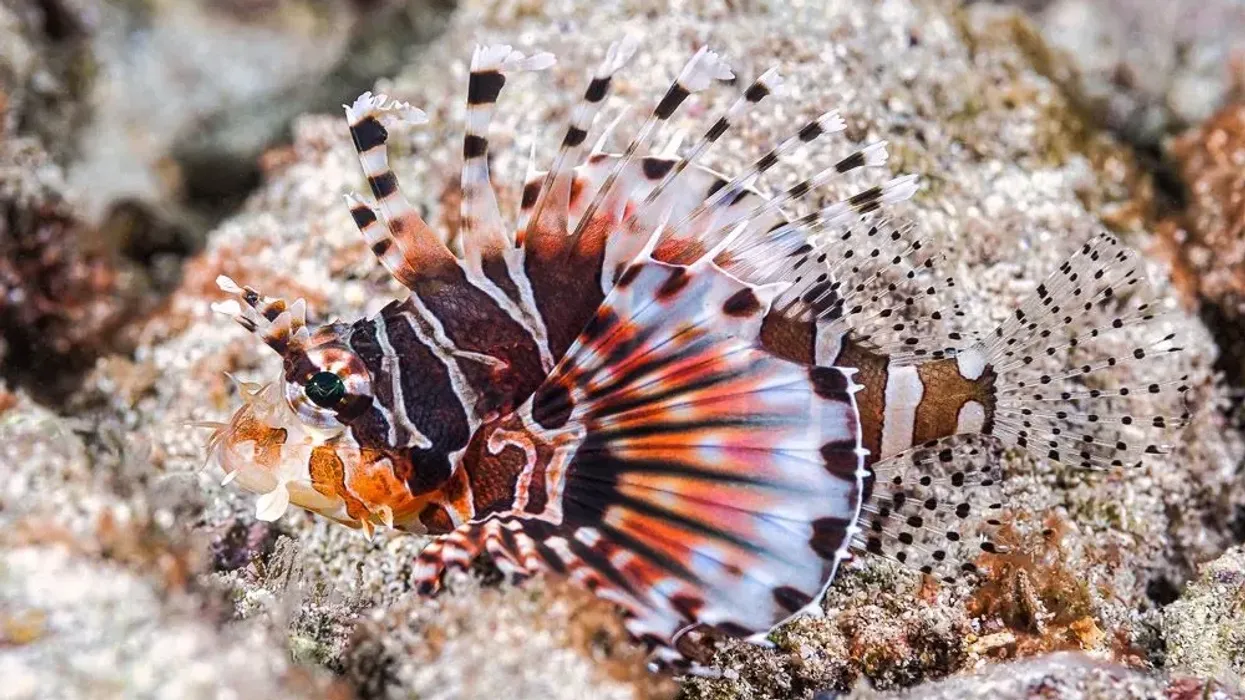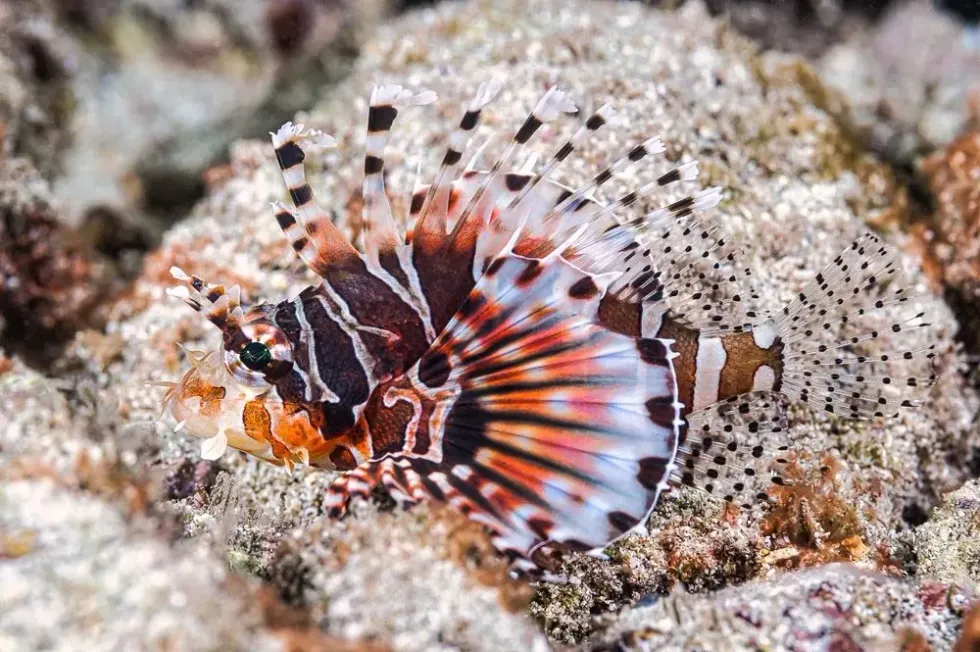The zebra lionfish (Dendrochirus zebra), commonly known as the dwarf lionfish, is a fish belonging to the family Scorpaenidae of the marine habitat. They are venomous predators and their diet mostly includes small marine organisms and fishes.
They have orange, white, and black vertical stripes on their body and broad, banded, fan-like pectoral fins that extend out on either side while the fish lays on the bottom.
Thirteen tall, quill-like spines make the front dorsal fin and the dorsal fin next to it have 10-11 smooth rays. The dwarf zebra lionfish has sharp red and white vertical stripes on its skin is said to be a very reserved species in many scientific ways and can be found in rock faces and ledges.
A zebra lionfish size can vary from 5-6 in (12.7-15.2 cm). It can be kept in a tank or aquarium.
The dwarf zebra lionfish tank size or the aquarium should be approximately 30 gal (114 l).
The dwarf zebra lionfish tank mates could not possibly be anything that would fit in a predator's mouth, for instance, leaf scorp, antennata, or snowflake. The red, white, and black vertical stripes seen along the body and fins led to the name 'dwarf zebra lionfish'.
If you enjoy reading about the dwarf zebra lionfish, you can also read interesting facts about immortal jellyfish and lungfish.
Zebra Lionfish Interesting Facts
What type of animal is a zebra lionfish?
The zebra lionfish (Dendrochirus zebra) is a venomous fish.
What class of animal does a zebra lionfish belong to?
These species belong to the class of fish.
How many zebra lionfish are there in the world?
The lionfish (Dendrochirus zebra) is considered to be of Least Concern by the IUCN. Hence there must be an adequate amount of them present. We can assume over 20,000 of them are present in the ocean.
Where does a zebra lionfish live?
Zebra lionfish (Dendrochirus zebra) including the dwarf lionfish are found vastly throughout the tropical waters of the Indo-West Pacific, along with the Red Sea. Their physical existence stretches from East Africa and the Red Sea to Samoa. The extreme northern specimens are found in south Japan and the southernmost ones are found in the waters of Australia.
What is a zebra lionfish's habitat?
The Dendrochirus zebra lionfish mainly exist mostly in all marine habitats, on corals, among rubbles, and over reef flats with rocky bottoms, but can also be found in coastal as well as outer reef environments in lagoons which are sheltered and caves, and they like warm or hot water.
Their living place is described as near and offshore coral and rocky reefs which are deep around 164 ft (50 m).
Moreover, in their natural range, the fishes appear in shallow coastal and estuarine waters, with the maximum population being in shallower inshore waters.
Who do zebra lionfish live with?
In the environment, fuzzy dwarf lionfish live alone or in groups of 3-10 individuals, although it is feasible to keep a huge dominant dwarf lionfish male and numerous females in a large home aquarium (100 gal or larger). Mostly, these invasive ones prefer an unaccompanied lifestyle.
How long does a zebra lionfish live?
Zebra lionfish or zebra turkeyfish can live up to 10-15 years and possibly longer.
How do they reproduce?
The zebra turkeyfish can reproduce in large numbers. It takes them less than a year to reach sexual maturity, and they reproduce all year in warmer waters. Females lay 15,000 -30,000 eggs per batch, allowing a single fish in hot water to produce up to two million eggs per year.
Several females may be associated with one male during breeding. Spawning takes place near the surface, with males fertilizing the released eggs almost immediately. The eggs hatch in around 36 hours and remain for up to 30 days.
What is their conservation status?
In their native area, they are not officially listed as Threatened or Endangered. However, increased pollution in coral reefs may have a negative impact on their principal food sources or diet (crustaceans and fish). Their populations may diminish if they are unable to adjust to changes in their food.
Zebra Lionfish Fun Facts
What do zebra lionfish look like?
The huge fan-shaped pectoral fins of the zebra turkeyfish give it a striking appearance. They have vertical bands on the body and are uniformly colored. Fins range in color from brown to reddish-brown to orange.
The fin is covered in rows of dots. Unless there is a stronger white stripe in the caudal area, the body color is normally red-brown with thin white vertical stripes. They have a thin outer layer of skin that sloughs off on a regular basis.
How cute are they?
The dwarf lionfish (Dendrochirus) is dazzlingly beautiful with its flashy vertical stripes, but its stripy dorsal fins are more of a look than touch, containing 18 venomous spines that are capable of penetrating human skin and delivering a very painful sting.
How do they communicate?
The species of dwarf lionfish communicate with other lionfish by using their fins to convey messages in the search for cooperative hunting. To communicate, it flares its pectoral fins, followed by a fast swish of the tail.
How big is a zebra lionfish?
The adult red dwarf lionfish is around 18.5 in (47 cm) long, whereas the dwarf lionfish is only 1 in (2.5 cm) long. It is bigger than milkfish and kelp rockfish.
How fast can a zebra lionfish swim?
The pace at which a zebra lionfish (Dendrochirus) can swim is unheard of, and it moves against the currents that follow the trade winds.
How much does a zebra lionfish weigh?
A zebra lionfish weighs approximately 2.5 lb (0.45-0.9 kg).
What are the male and female names of the species?
There are no definite names given to the male and female species of lionfish.
What would you call a baby zebra lionfish?
The baby Dendrochirus zebra lionfish are called fry.
What do they eat?
Dwarf lionfish are venomous voracious eaters who love to seek and consume live prey. The lionfish will spread its pectoral fins wide and push the prey back, trapping it until it can be swallowed whole when feeding.
Mollusks, drum fish, codfish, and even invertebrates make up the majority of the foods in their diet. They enjoy ambushing their victims to kill them.
Are they dangerous?
Dendrochirus zebra lionfish species are not poisonous but venomous fish as they have 13 quill-like spines along their back which are used to look after themselves. Dwarf lionfish are protected by them.
Each pelvic fin has one short spine on the leading edge, while the anal fin has three small poisonous spines on the leading edge. The fish moves slowly and quietly in search of prey. In order to avoid predators and search for prey, the fish rests in dark locations such as under a rock or coral.
Would they make a good pet?
The lionfish has not been domesticated as it is a spiky fish with spines. It has, however, been kept widely in an aquarium or tank. You can keep two males and females together, but same-sex lionfish may become aggressive.
Did you know...
Every four days, a female lionfish can discharge between 10,000-30,000 unfertilized eggs, totaling around two million eggs each year. Every spawn, she will usually release two egg sacs that are between one and two inches long.
The egg sac, of a female lionfish (Dendrochirus zebra), includes a chemical deterrent that prevents other fish from consuming the eggs.
The majority of the time, lionfish species are active during the day.
Are zebra lionfish reef safe?
Yes, Dendrochirus zebra are reef safe.
Are zebra lionfish poisonous?
The red lionfish's venom is exclusively defensive, delivered via an array of up to 18 needle-like dorsal fins. It captures prey, mostly fish and shrimp, using camouflage and lightning-fast reflexes.
A lionfish sting is exceedingly painful for humans, and it can cause nausea and respiratory problems. The red lionfish is known for its red and white zebra stripes, as well as its large, flashy pectoral fins, which deliver a poisonous sting that can induce excruciating pain, perspiration, respiratory trouble, and even paralysis.
Here at Kidadl, we have carefully created lots of interesting family-friendly animal facts for everyone to discover! For more relatable content, check out these swai fish facts and Oscar fish facts for kids.
You can even occupy yourself at home by coloring in one of our free printable zebra lionfish coloring pages.










